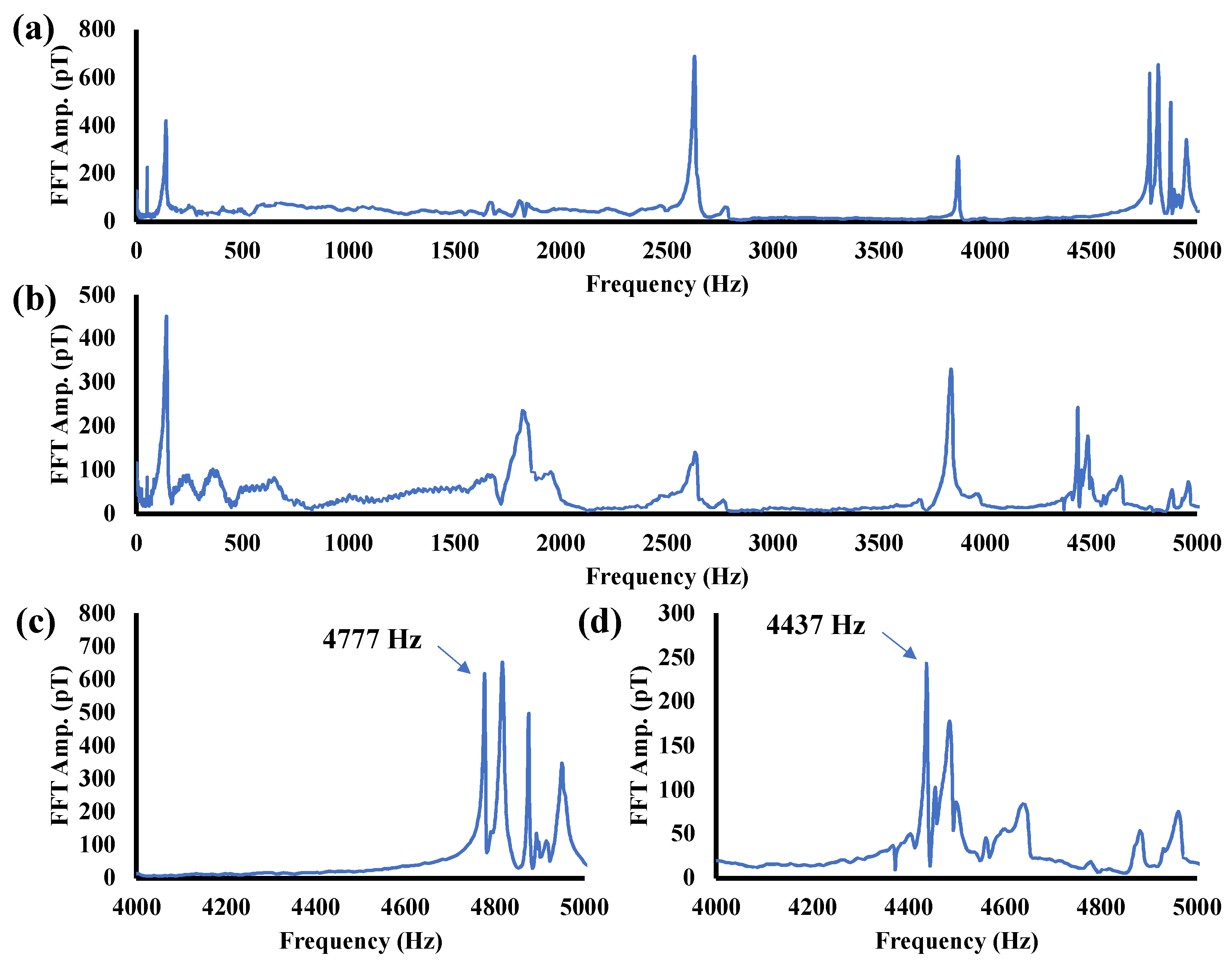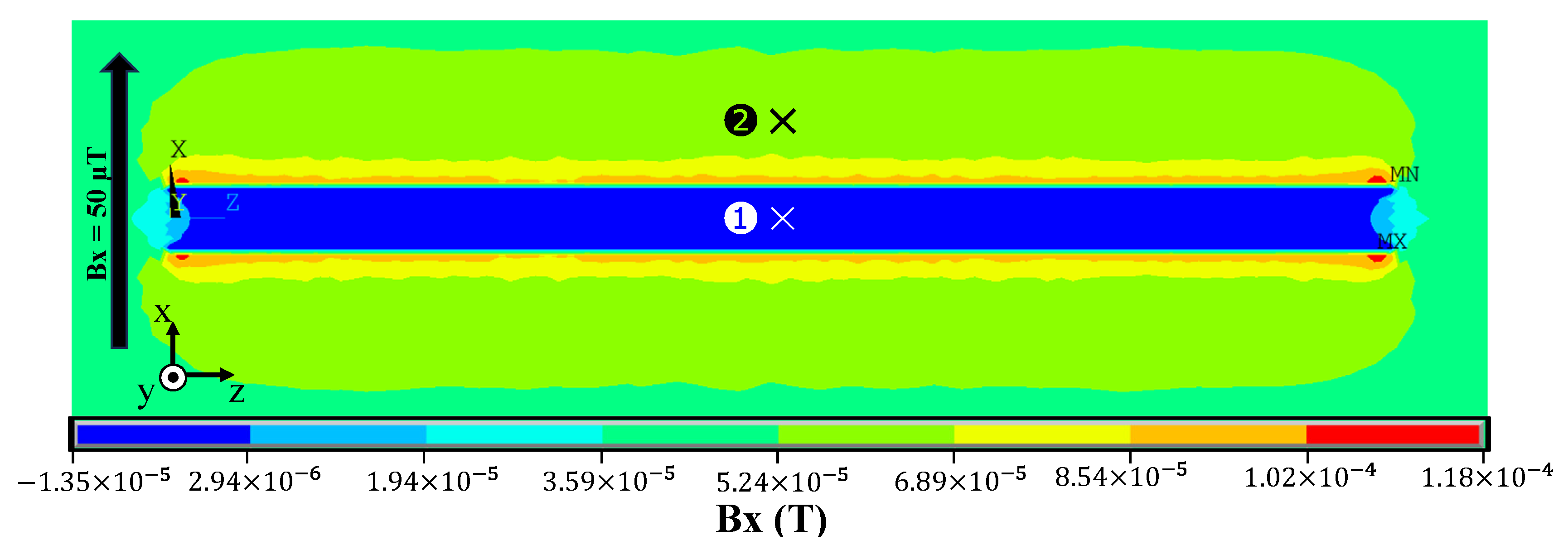Evaluation of Pipe Thickness by Magnetic Hammer Test with a Tunnel Magnetoresistive Sensor
Abstract
1. Introduction
1.1. Inspection of Pipelines
1.2. Magnetic Hammer Testing with Tunnel Magnetoresistive Sensor
2. Experimental Setup
2.1. Test Specimens and Experimental Setup
2.2. Sensor Performance
2.3. Sensitivity Calibration
2.4. Vibration Properties of Pipe
2.5. Magnetic Properties of Pipe
3. Results
3.1. Time Waveform and Spectrum of MHT Signal
3.2. Dependence of Natural Frequency on Pipe Thickness
3.3. Evaluation of Resolution of Pipe-Thickness Measurement
3.4. Discussion of the Experimental Results
4. Simulation Results Using FEM
4.1. Modeling and Structural Analysis
4.2. Structural–Magnetic Combined Analysis
4.3. Discussion of the Simulation Results
5. Conclusions
Author Contributions
Funding
Institutional Review Board Statement
Informed Consent Statement
Data Availability Statement
Acknowledgments
Conflicts of Interest
References
- Askari, M.; Aliofkhazraei, M.; Afroukhteh, S. A Comprehensive Review on Internal Corrosion and Cracking of Oil and Gas Pipelines. J. Nat. Gas Eng. 2019, 71, 102971. [Google Scholar] [CrossRef]
- Chen, B.-Q.; Zhang, X.; Guedes Soares, C. The Effect of General and Localized Corrosions on the Collapse Pressure of Subsea Pipelines. Ocean Eng. 2022, 247, 110719. [Google Scholar] [CrossRef]
- Kondo, M.; Kobayashi, M.; Nakano, N. Inspection and assessment technology for oil pipelines. JFE Technol. Rep. 2006, 11, 34–38. [Google Scholar]
- Eddyfi Technologies. Corrosion under Insulation (CUI) and Firprrofing (CUF): Eddyfi Technologies for CUI and CUF Inspection Applications. Available online: https://www.eddyfi.com/en/application/corrosion-under-insulation-cui-and-fireproofing-cuf (accessed on 30 November 2023).
- Ma, Q.; Tian, G.; Zeng, Y.; Li, R.; Song, H.; Wang, Z.; Gao, B.; Zeng, K. Pipeline In-Line Inspection Method, Instrumentation and Data Management. Sensors 2021, 21, 3862. [Google Scholar] [CrossRef]
- The Japan Petroleum Institute (JPI). JPI-8S-1-2018, Piping Inspection and Maintenance; The Japan Petroleum Institute: Tokyo, Japan, 2018. [Google Scholar]
- Shi, Y.; Zhang, C.; Li, R.; Cai, M.; Jia, G. Theory and Application of Magnetic Flux Leakage Pipeline Detection. Sensors 2015, 15, 31036–31055. [Google Scholar] [CrossRef]
- Dutta, S.M. Magnetic Flux Leakage Sensing: The Forward and Inverse Problems. Ph.D. Thesis, Rice University Mechanical Engineering, Houston, TX, USA, 2008. [Google Scholar]
- Da Silva, J.J.; Neff, F.H.; Lima, A.M.N.; da Rocha Neto, J.S. Hammer Impact Test Applied for Fouling Detection in Pipelines. SBA Controle Automação Soc. Bras. Autom. 2011, 22, 620–630. [Google Scholar] [CrossRef][Green Version]
- Ikeda, K.; Kamimura, A. Hammering Acoustic Analysis Using Machine Learning Techniques for Piping Inspection. J. Robot. Mechatron. 2020, 32, 789–797. [Google Scholar] [CrossRef]
- Azizinamini, A.; Gull, J. Improved inspection techniques for steel prestressing/post-tensioning strand. In FDOT Contract No. BDK80 977-13 Final Report—Volume I; Florida Department of Transportation, Florida International University: Miami, FL, USA, 2012. [Google Scholar]
- Kumar, A.; Arnold, W. High Resolution in Non-Destructive Testing: A Review. J. Appl. Phys. 2022, 132, 95328. [Google Scholar] [CrossRef]
- Wu, R.; Zhang, H.; Yang, R.; Chen, W.; Chen, G. Nondestructive Testing for Corrosion Evaluation of Metal under Coating. J. Sens. 2021, 2021, 6640406. [Google Scholar] [CrossRef]
- Wagner, R.; Goncalves, O.; Demma, A.; Lowe, M. Guided Wave Testing Performance Studies: Comparison with Ultrasonic and Magnetic Flux Leakage Pigs. Insight Non-Destr. Test. Cond. 2013, 55, 187–196. [Google Scholar] [CrossRef]
- Zhang, Y.; Xue, Y.; Huang, X.; Li, J.; Chen, S. Pipeline Inclination Measurements Based on a Spherical Detector with Magnetic Proximity Switches. IEEE Access 2018, 6, 39936–39943. [Google Scholar] [CrossRef]
- Hassani, S.; Dackermann, U. A Systematic Review of Advanced Sensor Technologies for Non-Destructive Testing and Structural Health Monitoring. Sensors 2023, 23, 2204. [Google Scholar] [CrossRef]
- Gucunski, N.; Imani, A.; Romero, F.; Nazarian, S.; Yuan, D.; Wiggenhauser, H.; Shokouhi, P.; Taffe, A.; Kutrubes, D. Nondestructive Testing to Identify Concrete Bridge Deck Deterioration; Transportation Research Board; The National Academies Press: Washington, DC, USA, 2012. [Google Scholar] [CrossRef]
- Ito, J.; Al-Mahdawi, M.; Oogane, M. Magnetic Hammer Testing with Tunnel Magnetoresistive Sensors. IEEE Trans. Magn. 2023, 59, 1–6. [Google Scholar] [CrossRef]
- Zhang, Y.; Hao, Q.; Xiao, G. Low-Frequency Noise of Magnetic Sensors Based on the Anomalous Hall Effect in Fe–Pt Alloys. Sensors 2019, 19, 3537. [Google Scholar] [CrossRef]
- Miyazaki, T.; Tezuka, N. Giant Magnetic Tunneling Effect in Fe/Al2O3/Fe Junction. J. Magn. Magn. Mater. 1995, 139, L231–L234. [Google Scholar] [CrossRef]
- Ikeda, S.; Hayakawa, J.; Ashizawa, Y.; Lee, Y.M.; Miura, K.; Hasegawa, H.; Tsunoda, M.; Matsukura, F.; Ohno, H. Tunnel Magnetoresistance of 604% at 300K by Suppression of Ta Diffusion in CoFeB/MgO/CoFeB Pseudo-Spin-Valves Annealed at High Temperature. Appl. Phys. Lett. 2008, 93, 2976435. [Google Scholar] [CrossRef]
- Ye, C.; Laureti, S.; Malekmohammadi, H.; Wang, Y.; Ricci, M. Swept-Frequency Eddy Current Excitation for TMR Array Sensor and Pulse-Compression: Feasibility Study and Quantitative Comparison of Time and Frequency Domains Processing. Measurement 2022, 187, 110249. [Google Scholar] [CrossRef]
- Oogane, M.; Fujiwara, K.; Kanno, A.; Nakano, T.; Wagatsuma, H.; Arimoto, T.; Mizukami, S.; Kumagai, S.; Matsuzaki, H.; Nakasato, N.; et al. Sub-pT Magnetic Field Detection by Tunnel Magneto-Resistive Sensors. Appl. Phys. Express 2021, 14, 123002. [Google Scholar] [CrossRef]
- Takata, S.; Inoue, H.; Shinoda, S. Proposal of the Pipe Diagnosis Method Using In-Plane Bending Vibration of Cylindrical Shell. Trans. JSME 2018, 84, 17-00522. [Google Scholar] [CrossRef]
- Vallen, H.; Thenikl, T. New Intrinsically Safe Acoustic Emission Sensor System for Use on Tank Ships. In Proceedings of the 30th European Conference on Acoustic Emission Testing & 7th International Conference on Acoustic Emission, Granada, Italy, 12–15 September 2012. [Google Scholar]
- IEC 60079-10-1:2008; Explosive Atmospheres-Part 10-1: Classification of Area-Explosive Gas Atmosphere. IEC Central Office: Geneva, Switzerland, 2008.
- Zheng, C.; Zhu, K.; Cardoso de Freitas, S.; Chang, J.-Y.; Davies, J.E.; Eames, P.; Freitas, P.P.; Kazakova, O.; Kim, C.; Leung, C.-W.; et al. Magnetoresistive Sensor Development Roadmap (Non-Recording Applications). IEEE Trans. Magn. 2019, 55, 1–30. [Google Scholar] [CrossRef]
- Japanese Standards Association. JIS Handbook 2: Ferrous Materials & Metallurgy II (Japanese Version); Japanese Standards Association: Tokyo, Japan, 2024. [Google Scholar]
- Timoshenko, S.P.; Woinowsky-krieger, S. Theory of Plates and Shells; McGraw Hill: New York, NY, USA, 1959; p. 3. [Google Scholar]
- Rayleigh, J.W.S.B. The Theory of Sound; Macmillan: London, UK, 1877. [Google Scholar]
- Koga, T. The minimum natural frequencies and vibration characteristics of circular cylindrical shells. Trans. JSME Ser. A 1980, 46, 1280–1289. [Google Scholar] [CrossRef]
- Koga, T. Natural Vibrations of a Cylindrical Shell and the Foundation of Shell Theory. Trans. JSME Ser. A 1987, 53, 1447–1452. [Google Scholar] [CrossRef][Green Version]
- Jaouhari, M.; Self, F.; Liu, Y. Differentiating between Acoustic and Flow Induced Vibrations; Bechtel Virtual Technology Expo 2018; Bechtel: Valley, QLD, Australia, 2018. [Google Scholar]
- Inoue, H.; Takata, S.; Shinoda, S. Simplified description of in-plane bending mode of cylindrical shell using two-dimensional ring model. In Proceedings of the Symposium on Evaluation and Diagnosis 16, Kumamoto, Japan, 1 December–30 November 2017; p. 109. [Google Scholar] [CrossRef]
- Xinjing, H.; Zan, L.; Yu, Z.; Yameng, X.; Jian, L. Analyses and Verifications of Magnetic Shielding of Long Pipelines Aiming for Pipeline Orientation Measurements. J. Magn. Magn. Mater. 2021, 517, 167369. [Google Scholar] [CrossRef]
- Celozzi, S.; Araneo, R.; Lovat, G. Electromagnetic Shielding; John Wiley & Sons Inc.: Hoboken, NJ, USA, 2008; pp. 164–199, 283–284. [Google Scholar] [CrossRef]
- Gohil, C.; Burrows, P.N.; Kraljevic, N.B.; Schulte, D.; Heilig, B. Measurements of Sub-NT Dynamic Magnetic Field Shielding with Soft Iron and Mu-Metal for Use in Linear Colliders. J. Instrum. 2020, 15, P12030. [Google Scholar] [CrossRef]
- Mager, A. Magnetic Shielding Efficiencies of Cylindrical Shells with Axis Parallel to the Field. J. Appl. Phys. 1968, 39, 1914. [Google Scholar] [CrossRef]
- Newville, M.; Stensitzki, T.; Allen, D.B.; Ingargiola, A. LMFIT: Non-Linear Least-Square Minimization and Curve-Fitting for Python; Release 1.0.3; Zenodo: Geneva, Switzerland, 2022. [Google Scholar] [CrossRef]











| Thickness (mm) | 5.66 ± 0.1 | 5.07 ± 0.1 | 4.82 ± 0.1 | 4.57 ± 0.1 | ||
| Amount of thinning (mm) | ----- | 0.50 | 0.75 | 1.00 | ||
| Above ground | Frequency (Hz) | 4776.62 ± 0.04 | 4437.32 ± 0.09 | 4061.46 ± 0.33 | 3665.17 ± 0.03 | |
| Accuracy (Hz) | 4.39 ± 0.12 | 4.67 ± 0.24 | 12.69 ± 1.19 | 14.17 ± 0.11 | ||
| 4 pipes | Sensitivity (Hz/mm) | 990.3 ± 155.6 | ||||
| Resolution (μm) | 4.4 ± 0.7 | 4.7 ± 0.8 | 12.8 ± 2.3 | 14.3 ± 2.3 | ||
| 3 pipes | Sensitivity (Hz/mm) | ----- | 1544.3 ± 16.7 | |||
| Resolution (μm) | ----- | 3.0 ± 0.2 | 8.2 ± 0.8 | 9.1 ± 0.1 | ||
| Underwater | Frequency (Hz) | 4120.16 ± 0.08 | 3579.45 ± 0.30 | 3443.34 ± 0.14 | 2989.00 ± 0.26 | |
| Accuracy (Hz) | 23.22 ± 0.23 | 32.12 ± 0.90 | 22.53 ± 0.44 | 66.43 ± 0.56 | ||
| 4 pipes | Sensitivity (Hz/mm) | 979.86 ± 108.6 | ||||
| Resolution (μm) | 23.6 ± 2.6 | 32.8 ± 3.7 | 23.0 ± 2.6 | 67.8 ± 7.5 | ||
| 3 pipes | Sensitivity (Hz/mm) | ----- | 1180.9 ± 259.8 | |||
| Resolution (μm) | ----- | 27.2 ± 6.0 | 19.1 ± 4.2 | 56.3 ± 12.4 | ||
| Parameters | Steel Pipe | Parameters | Inner Air | Parameters | Outer Air |
|---|---|---|---|---|---|
| Diameter (mm) | 60.5 | Diameter (mm) | 54.84 | X (mm) | 2000 |
| Thickness (mm) | 5.66 | ----- | ----- | Y (mm) | 2000 |
| Length (mm) | 1000 | Length (mm) | 1000 | Z (mm) | 3000 |
| Element shape | Hexahedral | Element shape | Hexahedral | Element shape | Tetrahedral |
| Element size (mm) | 10 | Element size (mm) | 10 | Element size (mm) | 50 |
| Element type | SOLID186 | Element type | SOLID186 | Element type | SOLID186 |
| Young’s modulus (Pa) | Young’s modulus (Pa) | 100 | Young’s modulus (Pa) | 100 | |
| Poisson’s ratio | 0.3 | Poisson’s ratio | 0 | Poisson’s ratio | 0 |
| Density (kg/m3) | 7850 | Density (kg/m3) | 1.16 | Density (kg/m3) | 1.16 |
| Relative permeability | 1000 | Relative permeability | 1 | Relative permeability | 1 |
Disclaimer/Publisher’s Note: The statements, opinions and data contained in all publications are solely those of the individual author(s) and contributor(s) and not of MDPI and/or the editor(s). MDPI and/or the editor(s) disclaim responsibility for any injury to people or property resulting from any ideas, methods, instructions or products referred to in the content. |
© 2024 by the authors. Licensee MDPI, Basel, Switzerland. This article is an open access article distributed under the terms and conditions of the Creative Commons Attribution (CC BY) license (https://creativecommons.org/licenses/by/4.0/).
Share and Cite
Ito, J.; Igarashi, Y.; Odagiri, R.; Suzuki, S.; Wagatsuma, H.; Sugiyama, K.; Oogane, M. Evaluation of Pipe Thickness by Magnetic Hammer Test with a Tunnel Magnetoresistive Sensor. Sensors 2024, 24, 1620. https://doi.org/10.3390/s24051620
Ito J, Igarashi Y, Odagiri R, Suzuki S, Wagatsuma H, Sugiyama K, Oogane M. Evaluation of Pipe Thickness by Magnetic Hammer Test with a Tunnel Magnetoresistive Sensor. Sensors. 2024; 24(5):1620. https://doi.org/10.3390/s24051620
Chicago/Turabian StyleIto, Jun, Yudai Igarashi, Ryota Odagiri, Shigetaka Suzuki, Hiroshi Wagatsuma, Kazuhiro Sugiyama, and Mikihiko Oogane. 2024. "Evaluation of Pipe Thickness by Magnetic Hammer Test with a Tunnel Magnetoresistive Sensor" Sensors 24, no. 5: 1620. https://doi.org/10.3390/s24051620
APA StyleIto, J., Igarashi, Y., Odagiri, R., Suzuki, S., Wagatsuma, H., Sugiyama, K., & Oogane, M. (2024). Evaluation of Pipe Thickness by Magnetic Hammer Test with a Tunnel Magnetoresistive Sensor. Sensors, 24(5), 1620. https://doi.org/10.3390/s24051620





